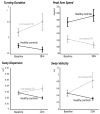Potential of APDM mobility lab for the monitoring of the progression of Parkinson's disease
- PMID: 26872510
- PMCID: PMC4959602
- DOI: 10.1586/17434440.2016.1153421
Potential of APDM mobility lab for the monitoring of the progression of Parkinson's disease
Abstract
APDM's Mobility Lab system provides portable, validated, reliable, objective measures of balance and gait that are sensitive to Parkinson's disease (PD). In this review, we describe the potential of objective measures collected with the Mobility Lab system for tracking longitudinal progression of PD. Balance and gait are among the most important motor impairments influencing quality of life for people with PD. Mobility Lab uses body-worn, Opal sensors on the legs, trunk and arms during prescribed tasks, such as the instrumented Get Up and Go test or quiet stance, to quickly quantify the quality of balance and gait in the clinical environment. The same Opal sensors can be sent home with patients to continuously monitor the quality of their daily activities. Objective measures have the potential to monitor progression of mobility impairments in PD throughout its course to improve patient care and accelerate clinical trials.
Keywords: Mobility; Parkinson’s disease; inertial sensors; mobility lab; objective measures.
Figures







References
-
- Bach JP, Ziegler U, Deuschl G, Dodel R, Doblhammer-Reiter G. Projected numbers of people with movement disorders in the years 2030 and 2050. Mov Disord. 2011;26:2286–90. Overview on the projected numbers of people with movement disorders. - PubMed
-
- Morris ME. Movement disorders in people with Parkinson disease: a model for physical therapy. Phys Ther. 2000;80:578–97. - PubMed
-
- Shoenberg BS. Epidemiology of movement disorders. In: Marsden CD, Fahn S, editors. Movement Disorders. Vol. 2. London, England: 1987. pp. 17–32.
-
- Mellone S, Palmerini L, Cappello A, Chiari L. Hilbert-Huang-based tremor removal to assess postural properties from accelerometers. IEEE Trans Biomed Eng. 2011;58:1752–61. - PubMed
Publication types
MeSH terms
Grants and funding
LinkOut - more resources
Full Text Sources
Other Literature Sources
Medical
Miscellaneous
